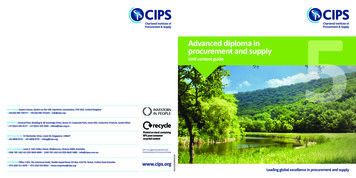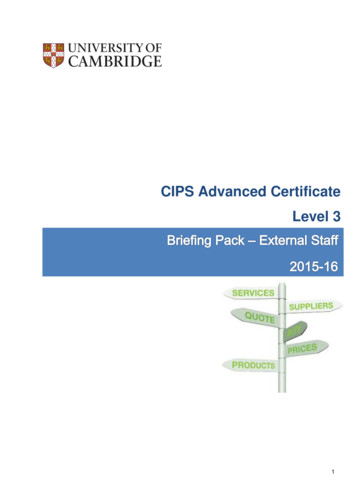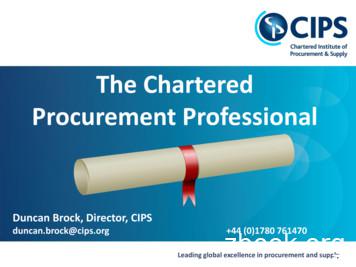CIPS Level 2 Certifıcate In 2 Procurement And Supply .
CIPS Level 2Certifıcate inProcurementand SupplyOperations2018 SyllabusVersion 12
YourqualifıcationThe Chartered Institute of Procurement & Supply (CIPS) qualifications are recognised by educationregulators from various countries. Our Level 2* Certificate in Procurement and Operations is avocationally related professional qualification. CIPS is an Ofqual (England), CCEA Regulation(Northern Ireland) and Qualifications Wales, regulated qualifications awarding organisation. TheCIPS qualifications are listed on the Regulated Qualifications Framework (RQF). CIPS members willbe able to have the confidence in our regulated qualifications, which reliably indicate theknowledge, skills and understanding that a learner is required to demonstrate.This is the first of CIPS entry level qualifications and issuitable for those who want to specialise in a specificoccupation, occupational area or technical role. It willprepare learners for work by giving them the opportunityto develop sector-specific knowledge, technical andpractical skills, and to apply these skills in work-relatedenvironments. This qualification supports learners withinoperational roles within the procurement and supplyprofession.Developed in close collaboration with experts from theprocurement and supply profession and businesses, andwith the providers who will be delivering the qualifications,CIPS Level 2 Certificate in Procurement and SupplyOperations is designed to develop transferable workplaceskills, such as good communication and the ability to work ina team; skills which employers have identified as essential forgaining employment in the sector and for progression in theprofession.Entry levelEntry levelHighest Entry levelLevel 2Certificate inProcurementand SupplyOperationsLevel 3Level 4Level 5Level 6AdvancedCertificate inProcurementand SupplyOperationsDiploma inProcurementandSupplyAdvancedDiploma inProcurementand SupplyProfessionalDiploma inProcurementand SupplyNext stepsThis qualification also provides progression to the CIPS Level 3Advanced Certificate in Procurement and Supply Operations,or CIPS Level 4 Diploma in Procurement and Supply,depending on your knowledge and experience.* Refers to levels within the RQF. Other regulatory bodies may have different corresponding levelsBased on the Tactical competency level of CIPS Global Standardcips.org/qualificationsLevel 3Level 4
18Guide to qualifıcation contentCreditsrequired forcompletionFive CORE MANDATORY modules make up the required 18 creditsCORE Level 2 Introducing Procurement and Supply (L2M1)6CREDITSCORE Level 2 Procurementand Supply Operations (L2M2)3CORE Level 2 StakeholderRelationships (L2M3)CREDITSCORE Level 2 SystemsTechnology (L2M4)3CREDITS3CREDITSCORE Level 2 Inventory,Logistics and Expediting(L2M5)3CREDITSWho is it for?For anyone new to the profession, with little or no business experience and those aspiring to move into acareer in procurement and supply.It is also ideal for managers in other professions and business leaders or entrepreneurs who need tounderstand how procurement should function and its overall impact on business success.What will I learn?Come away with a clear knowledge and understanding of facts, procedures and processes related toprocurement and supply. You’ll be able to effectively interpret information and ideas, and learn how toidentify, gather and use relevant information.Entry requirementsThis is the first entry level qualification, there are no formal entry requirements.Total credits required for completion 1803
Howlong willI study for?Your total qualification time (TQT)The TQT indicates the overall number of guided learning hours, additionalself-study and assessment time that is required.Guided learning hours (GLH)It is expected that you will undertake 120 GLH. The definition of guidedlearning hours is: ‘A measure of the amount of input time required toachieve the qualification. This includes lectures, tutorials and practicals,as well as supervised study in, for example, learning centres andworkshops’.Self-study requirement (SSR)Additionally, we recommend that you also commit to at least [54 SSR]hours. This includes wider reading of the subject areas and revision to giveyourself the best preparation for successfully achieving the qualification.Total exam timeAll the modules in CIPS qualifications are assessed by an examination.cips.org/qualifications180TQT HRS120GLH HRS54SSR HRS6HRS
CCORE MODULECIPS GLOBALSTANDARD1.1 4.1 8.1 11.12HRSEXAM DURATIONHOURS60HRSTOTAL QUALIFICATIONTIME (TQT)6IntroducingProcurementand Supply[L2M1]Module purposeOn completion of the module, learners will be able to identify the fundamental rolesand activities, the systems, procedures, processes and contracts associated with theprocurement and supply function.Module aim(s)In any organisation, many of the costs are related to the purchases of products and/or services. Any organisation will also be supplying products and/or services to theircustomers. This module is designed to provide an overview of the tasks associated withthe procurement and supply chain function. It is designed for those who are interested indeveloping their knowledge of procurement and supply and for those who are new to thisfield of work. The module serves as the initial study for learners who are embarking on theCIPS Level 2 Certificate in Procurement and Supply Operations. Coverage is focused onintroductions to concepts and ideas as well as to the terminology used in procurement andsupply.Credit value05
Learning outcomes, assessment criteria and indicative content1.0 Understand the role of procurement and supplywithin organisations2.0 Understand the organisational impact of procurementand supply1.1 Identify the common terms that describe aspects ofprocurement and supply Definitions of common terms such as procurement,purchasing, buying, supply chain, materialsmanagement, distribution, logistics and contractmanagement Definitions of different types of procurements suchas capital and revenue purchases, products, services,direct and indirect, outsourcing and insourcing Three sectors of activity: extraction of raw materials(primary), manufacturing (secondary), and services(tertiary)2.1 Identify how effective procurement impacts onorganisational efficiency How effective procurement impacts on profitability Creating savings and improving efficiency Budgets and budget monitoring How effective procurement helps achieve targets Total costs of ownership criteria or whole life costs The different objectives of a procurement and supplyfunction The creation of centralised, devolved and lead buyingstructures of procurement and supply functions.1.2 Explain the roles and benefits of procurement andsupply in organisations The typical proportion of costs accounted for byprocurement of goods and services The roles of procurement and supply andprocurement professionals Achieving value for money Sustainability in procurement and supply The roles of staff with devolved responsibilities forprocurement of goods and services The roles of procurement and supply staff in makingexpenditures with suppliers The tiers of a supply chain1.3 Define components of a supply chain Customers and their customers Customers and consumers Suppliers and their use of suppliers Tiers of a supply chain The global aspects of supply chains Examples of supply chains in actioncips.org/qualifications2.2 Define the five rights of procurement and supply The five rights of procurement and supply Price, total cost, quality, timing, quantity and place Defining value for money3.0 Know how products and services are received fromsuppliers and delivered to customers3.1 Identify the delivery of products and services made byexternal suppliers The need for supplies of products and services fromexternal suppliers Outsourced services Seeing suppliers as a part of a supply chain3.2 Identify the delivery of products and services thatorganisations make to customers Defining products and services The customer role Seeing customers as a part of a supply chain
4.0 Know the stages of the sourcing process4.1 Indicate stages of a sourcing process Identification of needs Producing specifications Requesting quotations Receiving quotations Assessing supplier quotations Making contract award recommendations Contract authorisation Order placement, blanket orders/frameworks andcall off orders Performance and delivery Payment of suppliers Expediting deliveries Reviewing outcomes and processes Pre and post award stages of a sourcing process5.0 Understand the need for the effective and efficientadministration of purchases made with externalsuppliers5.1 Describe and explain effective and efficientadministration Defining administration Reviewing the steps taken to forming agreementsmade with suppliers Defining effectiveness and efficiency5.2 Describe and explain effective and efficientadministration The creation of requisitions and requirements The use of specifications, key performance indicators(KPIs) and contract terms The creation of requests for quotations or invitationsto tender The use of prequalification questionnaires The submission of quotations or tenders forrequirements The assessment of quotations and tenders5.3 Describe the administration of the award and postaward stages of a sourcing process The creation of orders or tender awarddocumentation Delivery notes and order acknowledgements Receiving invoices Invoice matching and dealing with non-compliances5.4 Explain the need for approvals in the administrationof procurement and supply Typical procedures for authorising budgets,requisitions, orders and tenders The separation of duties Contract recommendation and authorisation Levels of delegated authority for contracts Ensuring an efficient approval process6.0 Know the importance of ethics and responsibleprocurement in organisations and supply chains6.1 Identify good ethical practices and procedures withinthe context of the procurement and supply function Application of the CIPS Code of Conduct Details included in ethical codes affectingprocurement and supply The use of ethical codes of practice The use of documented policies and procedures forthe work of procurement and supply The principles of corporate governance Forms of bonded and exploitative labour that canexist in supply chains07
Procurementand SupplyOperations[L2M2]Module purposeOn completion of the module, learners will be able to identify types of businessorganisations. They will define the fundamentals and components of the contractingprocess, identify sources of information on suppliers and customers and define pricingmethods used for the purchasing of goods or services.Module aim(s)In any organisation, a significant element of the procurement and supply function isbased around the contracting process. This module is designed for those involved in theprocurement and supply operation who, to ensure success must demonstrate knowledgeand comprehension of the associated components and systems that are at their disposalto support the contracting process. They must also know where sources of information onsuppliers and customers are and recognise the advantages and disadvantages of pricingmethods used for the purchasing of goods or services.Credit value cips.org/qualificationsCCORE MODULECIPS GLOBALSTANDARD4.2 6.11HREXAM DURATIONHOURS30HRSTOTAL QUALIFICATIONTIME (TQT)3
Learning outcomes, assessment criteria and indicative content1.0 Know the types of organisations and how they operate1.1 Identify the types of business organisations Private public and third sector organisations Production and service organisations1.2 Describe how organisations operate People, objectives and structure in organisations The formal and informal organisation1.3 Identify the key operating functions withinorganisations Differentiation and integration in organisations Typical functions in organisations such as production,operations, marketing and sales, customersupport,human resources, personnel, finance, IT, andtechnical functions Differentiating procurement and supply2.0 Know the components of contractual agreements2.1 Identify types of contracts Spot purchases Term contracts Framework arrangements/blanket orders/panelcontracts and call offs2.2 Identify the kind of pricing arrangements applied incommercial contracts Fixed pricing, lump sum pricing and schedule of rates Cost reimbursable and cost plus arrangements Variable pricing arrangements Target pricing arrangements Risk and reward pricing arrangements2.3 Define the different documents that compose acontract for the purchase or supply of goods orservices Defining contracts and agreements The use of tendering and quotations The documents that comprise a contract - thespecification, key performance indicators (KPIs),contract terms, pricing and use of other schedules Contracts for the supply of goods or services3.0 Understand sources of information on suppliers andcustomers3.1 Explain the use of the Internet to locate details aboutsuppliers and customers The use of Internet search engines to locate detailsabout suppliers and customers The types of information presented by suppliers andcustomers on their websites B2B and B2C E-Commerce3.2 Explain the use of credit rating agencies The role of credit rating agencies and credit ratingscores Publications on individual organisations and markets The use of credit rating scores3.3 Describe systems used in procurement and supply Systems for purchase ordering Capturing data on expenditures The use of portal sites to locate suppliers orcustomers Examples of supplier database systems4.0 Understand pricing methods used for the purchasingof goods or services4.1 Explain the advantages and disadvantages of a rangeof pricing methods Fixed pricing, lump sum pricing and schedule of rates Cost reimbursable and cost plus arrangements Variable pricing Target pricing Risk and rewards pricing09
StakeholderRelationshipsCCORE MODULE[L2M3]CIPS GLOBALSTANDARD1.1 5.1 9.1 9.2Module purposeOn completion of this module, learners will be able to define stakeholders and explain thekey market factors that impact on the procurement and supply function. They will alsodefine the role of effective communication in the successful development and maintenanceof internal and external relationships.Module aim(s)In any organisation, much of the procurement and supply function is based around thedevelopment and maintenance of relationships with internal or external stakeholders. Thismodule is designed for those involved in the procurement and supply operation who mustidentify stakeholders and key market factors which affect procurement and supply success.They must also know the communication tools and techniques that will ensure successfulworking relationships.Credit value cips.org/qualifications1HREXAM DURATIONHOURS30HRSTOTAL QUALIFICATIONTIME (TQT)3
Learning outcomes, assessment criteria and indicative content1.0 Know the stakeholders in procurement and supply1.1 Define external stakeholders in procurement andsupply Defining and profiling stakeholders Typical stakeholders such as suppliers, customers,consumers, communities, government and othergroups The distinction between customers and consumers1.2 Identify internal stakeholders that can be involved inpurchases from suppliers and supplies delivered tocustomers The role of procurement and supply in dealing withother business functions such as marketing, sales,production, operations, human resources, finance,design and development, distribution, facilities,senior management and the board of management1.3 Describe how internal and external stakeholdersinfluence procurement and supply activity The internal and external stakeholders that caninfluence the work and success of procurement andsupply2.0 Know the key market factors that impact on aprocurement and supply function2.1 Identify the key economic sectors that impact on aprocurement and supply function Public, private and not-for-profit or third sector Primary, secondary and tertiary sectors2.2 Indicate the impact of demand and supply on markets Demand and supply curves How demand and supply factors can change How demand and supply factors can impact onpricing and availability2.3 Describe how market factors impact on theprocurement and supply activities of an organisation The level of competition: perfect competition,imperfect competition, oligopoly, duopoly andmonopolies The impact of demand on sales Market growth and decline Competitive forces on organisations2.4 Identify the contribution that marketing makes todevelop customer and supplier relationships Define the principles and definitions of marketing Techniques associated with marketing Sources of competitive advantage sought throughmarketing Relevance of marketing principles to purchasers3.0 Understand the techniques associated with successfuland effective communication in procurement andsupply3.1 Describe and explain approaches to build rapport withinternal and external stakeholders Techniques to develop, maintain and improverelationships with internal stakeholders to promoteeffective procurement and supply3.2 Explain methods of negotiating with suppliers andcustomers Negotiation techniques for use with suppliers andcustomers to agree contract terms and relationshipsthat will achieve the interests of the overallorganisation3.3 Recognise all elements of the communication cycle The importance of appropriate, prompt and timelycommunications with stakeholders and suppliers How to create appropriate written correspondence How to complete electronic files and documentsused in support of the procurement and supplyprocess3.4 Describe the key characteristics of successful andeffective team working Group cohesiveness and performance The characteristics of an effective work group The stages of team development4.0 Know approaches for conflict resolution withstakeholders in procurement and supply4.1 Identify the types of information that can beexchanged between purchasers and suppliers Types of information exchange such as schedulingdifficulties, demand forecasts, trends in costs andavailability, designs and innovations and new productdevelopment4.2 Indicate how conflict can arise in the work ofprocurement and supply Defining workplace conflict The sources of conflict in organisations and betweenpersonnel The sources of conflict between organisations andtheir personnel4.3 Identify approaches to conflict resolution withstakeholders in procurement and supply Approaches to conflict resolution Clarifying roles and responsibilities Group cohesion Achieving buy-in from stakeholders11
SystemsTechnologyCCORE MODULE[L2M4]CIPS GLOBALSTANDARD3.1 3.2 8.1Module purposeOn completion of this module, learners will be able to define the uses of, and identify theadvantages offered by systems technology in improving procurement and supply activitywhilst maintaining overall quality.Module aim(s)The impact of Internet based technologies and the use of data base information systemsis key to the ability of the organisation to manage its expenditures on goods and services.This module is designed for those involved in the procurement and supply operation who,to ensure success must identify advantages of current technology but must also knowthe importance of quality management as efficiencies are sought through continuousimprovement to organisational performance.Credit value cips.org/qualifications1HREXAM DURATIONHOURS30HRSTOTAL QUALIFICATIONTIME (TQT)3
Learning outcomes, assessment criteria and indicative content1.0 Understand the use of systems technology anddatabases and how they contribute to procurementand supply1.1 Explain how to use systems technology and databasesto contribute to effective procurement and supply Inputting of data to systems to perform key tasks forp
Introducing Procurement and Supply [L2M1] Module purpose On completion of the module, learners will be able to identify the fundamental roles and activities, the systems, procedures, processes and contracts associated with the procurement and supply function. Module aim(s)
CIPS Asia PacificIG Rochester Drive, Level HJ, Singapore, GINLIM TPLK LNFN NMHG FPLK LNFN NMHH Einfosg@cips.org CIPS AustralasiaLevel H, KHF Collins Street, Melbourne, Victoria IFFF, Australia TGIFF MLK GJH/PLG (F)I OLHO LFFF FGIFF MLK GJI/PLG (F)I OLHF KJNN Einfo@cipsa.com.au CIPS MENAOffice GMFI, The Fairmont Hotel, Sheikh Zayed Road, PO Box GGOMMJ, Dubai, United Arab Emirates TPOMG (F)J IGG .
CIPS Level 5 5 Advanced Diploma in Procurement and Supply Ref: 603/3925/1 6\OODEXV Version 1 Fhyzics Business Consultants Pvt. Ltd. An Approved Study Centre of CIPS, UK www.IISCM.org cs@fhyzics.net 91 900-304-9000. Your TXDOLIÂFDWLRQ Next steps 7KLV TXDOL 4FDWLRQ SURYLGHV SURJUHVVLRQ WR WKH CIPS Level 6 Professional Diploma in Procurement and Supply. 5HIHUV WR OHYHOV ZLWKLQ WKH 8. 54 .
The University CIPS Level 3 Programme 2.1. About the CIPS Programme The University’s CIPS Level 3, Advanced Certificate in Procurement and Supply Operations programme is partly funded through the Finance Division. You may apply if you work in one of the University colleges, the University Press or Cambridge Assessment or other associated institution, although funding will be requested from .
Leading global excellence in procurement and supply 1 The Chartered Procurement Professional Duncan Brock, Director, CIPS duncan.brock@cips.org 44 (0)1780 761470 . Leading global excellence in procurement and supply 2 Introducing CIPS Chartered Body Charitable Status Awarding Body Membership Organisation CIPS for Business . Leading global .
platforms/channels,, you agree to accept any changes made to the terms and conditions. CIPS Membership Subscriptions and MyCIPS CIPS Membership subscriptions and all CIPS membership fees quoted are for annual subscriptions (12- months). You are required to renew and mak
CIPS Position on Practice P&SM: Contract . Management . The activities of a buyer before, durin g and after a contract is signed, to ensure that all parties to the contract understand and fulfil their contractual obligations. CIPS members can record one CPD hour for reading a CIPS Knowledge
It is designed as a follow on from the CIPS Level 2 Certificate in Procurement and Supply Operations as learners are expected to develop, use and apply the professional language and skill sets introduced at Level 2 within a practical working environment. Individuals will be working at the Tactical but moving towards the Operational level of the CIPS Global Standard for Procurement and Supply .
CIPS Level 3 Advanced Certificate in Procurement and Supply Operations is designed for individuals who will be working at the Tactical but moving towards the Operational level of the CIPS Global Standard for Procurement and Supply. This is the first level of























